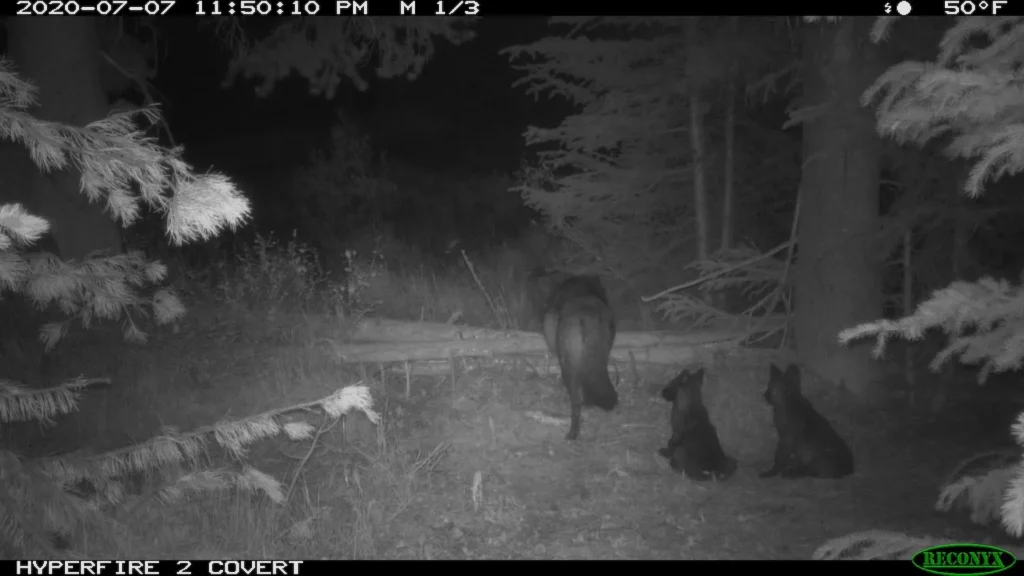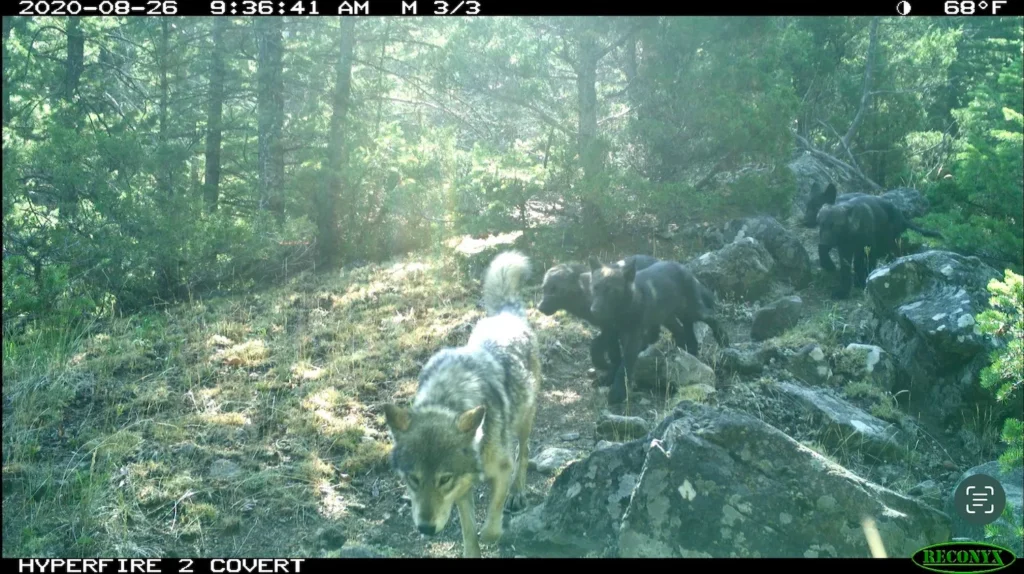Study refutes widespread understanding that gray wolves, anchored by young offspring, don’t move during spring denning season.
By Katie Klingsporn WYOFILE
Scientific research has long assumed gray wolves are non-migratory during springtime, staying anchored to tend to litters of nearly helpless pups. For the first weeks of life, after all, pups are blind, deaf and extremely vulnerable.
A game camera image captured in the Greater Yellowstone Ecosystem, however, upends that assumption. In the picture, an adult female wolf hauls a squirmy-looking pup by its hindquarters. The collared female, GPS data shows, was transporting the youngster from a den site to a new pack “rendezvous” site — effectively relocating her young family.
The photograph is part of a study, “Wolves use diverse tactics to track partially migratory prey,” that sheds new light on the evolving dynamics between ungulates and the carnivores that prey on them.
The study, published Aug. 1 in the journal Current Biology, finds that canids with very young pups relocate homesites if their source of prey — in this case, elk — migrate.
The research helps illuminate the ways shifting ungulate migrations can impact predator behaviors and ecosystem dynamics, said senior author Arthur Middleton, a University of California, Berkeley, professor who has spent years researching ungulate migration and conservation in Wyoming.
“It’s sort of become pretty obvious to me that [ungulate migrations are] really important to the functioning of the ecosystem,” Middleton said. “But, we’ve had work to do to show how and why, and so I think this helps add another piece of that puzzle.”
This puzzle piece relates to the ways ungulate movements can directly influence the behavior of large carnivores. “That has broader implications, I think, for how we think about the migrations and why we’re trying to conserve them and things like that,” Middleton said.
Tracking movements
The research team set out in 2019 to learn about wolf predation in more granular detail, said co-author Avery Shawler. To do that, researchers partnered with the Wyoming Game and Fish Department to put collars on both prey — nearly 100 members of the large Cody elk herd — as well as their predators — 19 wolves belonging to seven packs.
“So we were investigating wolf kill sites to see what they were killing and eating,” said Shawler, who completed her PhD at UC Berkeley in 2024.
This study area is east of Yellowstone National Park in the Absaroka Mountains, a rugged landscape home to high-alpine meadows, Douglas fir forests, aspen glades and sagebrush steppe.
Over summer and winter seasons through 2021, scientists collected a great deal of data on the movement patterns of the animals, Shawler said.

That allowed researchers “to do movement analyses and compare GPS collar information,” she said. Through that, they realized “that different wolf packs have different strategies for tracking the Cody elk herd, which has individuals that migrate and individuals that don’t migrate.”
Wyoming Game and Fish game camera images helped bolster the collar observations.
Ultimate findings demonstrated that gray wolves use diverse movement tactics to track partially migratory elk. Some Yellowstone Ecosystem elk only migrate short distances in the spring, and the wolf packs that tracked them generally stayed in the territory where they first established their dens. Other elk travel longer springtime distances, and the wolf packs that tracked them went to greater lengths to keep close. That includes packs with pups shifting homesites to follow migratory elk to summer range. Sometimes they carried small pups as far as 20 kilometers from their original dens.
Because the highest source of wolf mortality can be attributed to members of other packs killing puppies, moving them is risky, Shawler said.
The relocation of small pups was not a surprise to Game and Fish biologists and other large carnivore specialists, Shawler and Middleton said. Experts have observed that behavior on the ground for years. The finer-scaled detail provided by GPS collars confirmed their observations.

But, Middleton said, these findings counter years of assumptions by the larger body of animal researchers that migratory ungulates can escape predation in spring because wolves are anchored to dens and their largely immobile pups. The study is the first time researchers outside of the Arctic have observed gray wolves shifting their territorial range to be closer to prey during pup-rearing season.
The game camera photo captured it perfectly, Shawler noted. “Once they got that camera trap photo, literally of an adult wolf carrying a pup that was really, really young … It was like, ‘Oh, they actually are moving the pups, and that’s over some really rugged terrain, over a pretty long distance.’”
Implications
Previous work by Middleton illustrated that elk are highly variable and have the means to adapt to changing climate cues.
This study takes that a step further, Shawler said.
“There’s less research on how predators respond to that flexibility, and it would make sense that predators are also able to adapt,” she said. “So it’s just kind of adding to that literature.”
Understanding how wolves adapt to the prey’s behavior can help land managers better conserve both species, Middleton said. The study area, outside of Yellowstone National Park boundaries, encompasses human development like ranches and wilderness. That makes it a candidate for human-wildlife conflict.
Researchers generated a significant body of data, and Shawler is working to publish further work from it.
Additional study co-authors include Kenneth J. Mills and Tony W. Mong of the Wyoming Game and Fish Department; Kristin J. Barker of UC Berkeley and Beyond Yellowstone Living Lab; and Wenjing Xu of the Senckenberg Biodiversity and Climate Research Centre in Germany.
The National Geographic Society, Knobloch Family Foundation, George B. Storer Foundation, Wyoming Game and Fish Department, UC Berkeley and USDA National Institute of Food and Agriculture supported the study, which was conducted from a base at the Buffalo Bill Center of the West in Cody.















